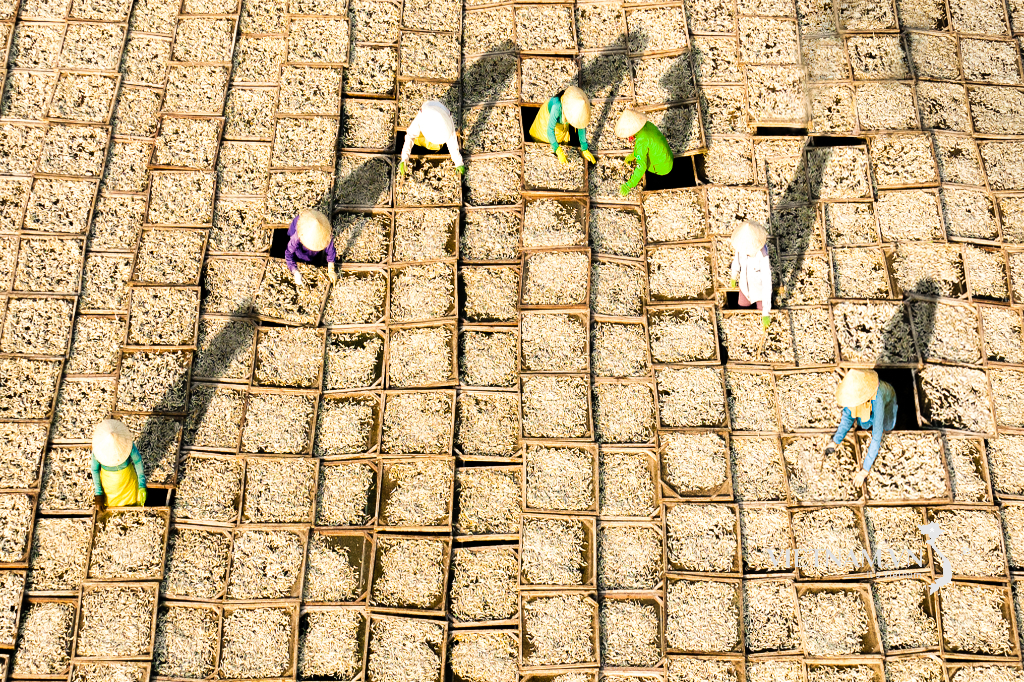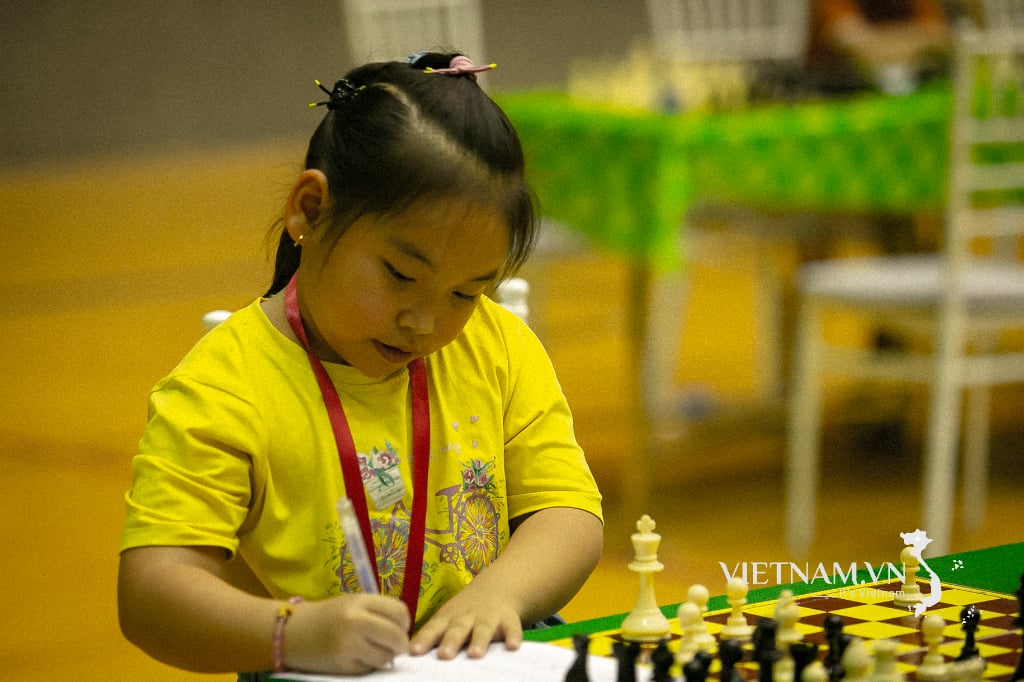 |
| Gentle Hue schoolgirls. Photo: Minh Thu |
When going to the market, my mother was often in a hurry, so she would wear a smoky-colored ao dai (traditional Vietnamese dress) and only fasten three buttons at the collar, armpits, and waist, but she still looked elegant. I was fascinated watching my mother stand in front of the mirror, styling her hair and wearing a white silk ao dai, secretly wishing that when I grew up I would wear an ao dai like that.
Back then, wherever I went, I saw women wearing the ao dai (traditional Vietnamese dress). At the market, on the streets, the women selling noodles and sweet soups, the elderly women selling porridge and rice noodles, the women selling tofu and vegetables, even the aunts selling firewood and charcoal... they all wore ao dai and still moved around and traded conveniently, without any hindrance. The aunts selling firewood and charcoal would tuck the four corners of their ao dai into their waistbands and roll up their trousers, carrying their firewood briskly. Going out in an ao dai was a normal part of life for all women.
A little older, I went to Hue and was accepted into the third year C2 (10th grade) by the Board of Directors of Dong Khanh School based on my academic record. Dong Khanh School, the largest girls' high school in Central Vietnam, was the dream of countless generations of female students. During the back-to-school season, Hue was filled with girls in white uniforms. From the day I became a Dong Khanh student, with the letters "DK" embroidered in dark blue on my chest, whenever I returned to my village, everyone would praise me: "You've grown into a young lady, so gentle, and you're a Dong Khanh student!"
In our time, the Raglan-sleeved ao dai was fashionable. The long skirt extended past the knees, making it easy to move around on foot, bicycles, and motorbikes. Not only at Dong Khanh, but also at other schools, including the Jeanne d'Arc School, most female students wore white ao dai, while the Model School wore sky-blue ones. Back then, my friends and I didn't know how beautiful the white ao dai was, while writers and poets, each in their own way, wholeheartedly praised it.
Since ancient times, the renowned and romantic musician Van Cao visited this city and, perhaps captivated by a particular "dress," left behind beautiful verses: "One cold night playing music on the Hue River / Oh, how I long for that green dress!" Do Trung Quan once confessed: "Every time I go out and see schoolgirls strolling in their white dresses, I don't know how long I'll continue to yearn for them."
“The ao dai is like a river of time, a river of beauty flowing through a woman, causing her heart to become stranded, or perhaps it is this magnificent river that makes men drown in the ao dai, leaving their romantic hearts forever trapped there. Watching the “ Fashion of the Year 2000” show by the Young Fashion Magazine, I learned that the ao dai is transforming into all modern fashion, as a source of pride for the eternal beauty of a nation that wears the ao dai with its two panels representing the Truong Son Mountains and the East Sea, thus shaping Vietnamese history. That ao dai is not only a philosophy of life, but also culture, the aesthetic history of Vietnam flowing on the graceful bodies of the descendants of Mother Au Co. That ao dai makes my soul transform into clouds, into a spring breeze drifting aimlessly…” A profound and insightful gaze on women and the ao dai by writer, researcher, and literary critic Tran Manh Hao.
Professor Nguyen Ngoc Lan, who came from Saigon to teach, was so moved that he called Le Loi Street the "White Street" whenever the Dong Khanh girls' school days ended. That cascading white stream of water has captivated the hearts of countless travelers who visited Hue and left them reluctant to leave.
The traditional Vietnamese ao dai has evolved through the ages, ever since the talented artist Nguyen Cat Tuong designed the first LEMUR ao dai – a unique beauty gifted to women in 1934. In the 1960s, this flowing ao dai was captivatingly beautiful, accentuating the slender waist. At that time, screen stars like Tham Thuy Hang, Kieu Chinh, Kim Cuong… and successful singers like Thai Thanh, Khanh Ly, Le Thu… all wore the modest ao dai whenever they appeared in public on stages and at music venues both domestically and internationally – very Vietnamese, very elegant, and unusually alluring!
The country was reunified. In an effort to heal the wounds of war, alongside achievements in economics, culture, and society, it is regrettable that the cultural city of Hue sometimes lacked the ao dai (traditional Vietnamese dress), not only worn by female students, teachers, and civil servants, but also by elderly women and grandmothers. Those ao dai of a beautiful era in Hue were folded up and stored away in chests and wardrobes. But after decades, the ao dai is gradually returning to Hue, not only at Hai Ba Trung School but also in the aviation, postal , and banking sectors.
Watching the Ao Dai Festivals at the Hue Festivals from 2000 to 2014, designers Minh Hanh, Si Hoang, Chu La (a Spaniard), many other designers, and director Quang Tu have seen the Ao Dai as an integral part of Vietnamese culture, a source of creative inspiration that elevates it, transforming it into modern fashion so that it doesn't disappear in the face of an increasingly fast-paced life, but remains enduring over time – truly representing the pure Vietnamese clothing culture that has existed for thousands of years for both Vietnamese women and men.
For many years now, every time I walk down the street on Mondays, I like to take Nguyen Truong To Street, then turn onto Le Loi Street to rediscover myself – those innocent days of wearing white school uniforms – to watch the girls from Hai Ba Trung High School going to and from school. To admire their ao dai dresses and the flowing black hair of their youth...
Former Đồng Khánh High School girls, whenever they visit Gác Trịnh café, still wear their traditional ao dai dresses, visiting the attic of musician Trịnh Công Sơn – the cradle of countless immortal love songs he left behind. Here, my friends and I have "warmed up Gác Trịnh" to express our gratitude to this talented musician with programs like "Calling the Four Seasons," featuring his music. Professor, writer, researcher, and translator Bửu Ý – a close friend of Sơn – was always present at each program. Bửu Ý said, "We come to listen to Sơn's music and to admire the ao dai!"
In everyone's eyes, Hue is now more beautiful with many wide, clean, tree-lined streets... Occasionally, you can still see Hue schoolgirls and women in their ao dai (traditional Vietnamese dress) and conical hats riding bicycles on the streets in the mornings and afternoons... It is hoped that not only in offices and schools, but also in the daily lives of the elderly women, aunts, and street vendors, and the older ladies and women in general, the ao dai will be worn more widely and on more days, because this is truly "Hue - The Capital of Ao Dai," a way to make this cultural heritage city as gentle as the Perfume River amidst the bustling traffic on its roads...
Source




![[Photo] Prime Minister Pham Minh Chinh presides over the conference announcing the establishment of the International Finance Centre in Vietnam.](/_next/image?url=https%3A%2F%2Fvphoto.vietnam.vn%2Fthumb%2F1200x675%2Fvietnam%2Fresource%2FIMAGE%2F2025%2F12%2F21%2F1766309817714_ndo_br_dsc-3400-jpg.webp&w=3840&q=75)

![[Photo] Prime Minister Pham Minh Chinh presides over a meeting on private sector economic development.](/_next/image?url=https%3A%2F%2Fvphoto.vietnam.vn%2Fthumb%2F1200x675%2Fvietnam%2Fresource%2FIMAGE%2F2025%2F12%2F20%2F1766237501876_thiet-ke-chua-co-ten-40-png.webp&w=3840&q=75)



























































































Comment (0)